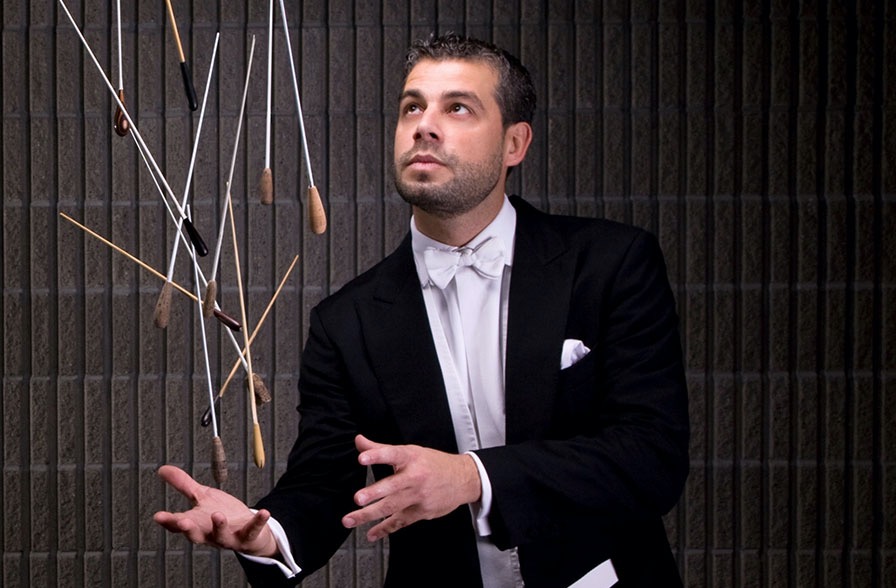An energetic Bignamini leans a little too hard into his Dallas Symphony debut

Making his conducting debut with the Dallas Symphony Orchestra Thursday night, Jader Bignamini led a reading of four hefty works by Prokofiev, Dvořák and Tchaikovsky. Violinist Gil Shaham lent his bravura for Dvořák’s Violin Concerto, but the overall collaboration yielded a presentation that tended to be heavy-handed and dynamically clamorous.
Prokofiev’s affectionate homage to Haydn, his Classical Symphony opens with a dapper, concise declamation in the orchestra. The second theme of the first movement highlights the composer’s mimicry of Haydn and Mozart’s first-movement form with a contrasting second theme that minces lightly as the violins play softly on the tip of the bow. Here, Bignamini and the orchestra read a bit heavy, with a hurried tempo in the first theme and louder than desired pianos.
The second movement of the 12-minute symphony, however, came across with more elegance and sensitivity. The gentle rocking of orchestral accompaniment made for a solid backdrop for the stately melodic line provided by first violins, while Bignamini was expressive in the left hand, drawing out a solid solo read from the flute. The dashing finale, a molto vivace, was, again, rushed and a bit loud.
Dvořák’s concerto for violin and orchestra was given a rather detached read. The opening fanfare theme in the orchestra was full and bright, but the following figure in solo violin felt unbalanced in tone and texture against the accompanying wind section. Bignamini’s background in conducting for opera served him well in providing a sturdy and expressive line for the soloist to follow, but left the ensemble in what felt like rhythmic ambiguity. Still, Shaham demonstrated virtuosity and skill — utterly alive in the numerous striking phrases of the first movement and appropriately warm in the closing cadenza that led seamlessly into the slower second movement.
Here, soloist and orchestra were cohesive. Shaham’s melody arched sweetly before presenting a bold contrast in sonorous octaves and sweeping arpeggios. The mellow echoing of the second movement’s opening melody in French horn was well-executed before entering into the final allegro giocoso. Shaham’s announcement of the syncopated theme was bright, and each section’s reiteration was tight throughout the refrain. Overall, the presentation could’ve done with more dynamic shifts in weight and volume. Nevertheless, the performance earned the soloist and conductor a hearty standing ovation.
For an encore, Shaham played graciously alongside DSO co-concertmaster Nathan Olson in a duet by Jean Marie Leclair.
The second half of the program saw a rather boisterous presentation of Dvořák’s Carnival Overture. The brilliant orchestral tutti that opens the piece set an exuberant pace for the reeling melodies that follow. Lovely, languorous solos from the winds and horns characterize the work’s pensive middle, though the pianissimos were not quite as contained in Thursday night’s read.
It is an overall raucous work, emulating the frantic hurly-burly of life through lively dance rhythms and pointed moments of meditation. Bignamini lent the interpretation a convincing drive through the final allegro, culminating in dazzling orchestral exclamation at the finish.
Closing the program was Tchaikovsky’s fantasia, Francesca da Rimini, which depicts the second circle of Dante’s Hell wherein the heroine Francesca and her illicit lover Paolo are damned to eternal torment. Initially slated as a full opera, the orchestral fantasy follows Dante’s description of his meeting with the poor, doomed souls.
The opening andante lugubre, intended to recall the inscription on the gateway to Hell: “Abandon all hope, ye who enter here,” lacked the requisite heft on Thursday night, with phrasing that was more muddy than imposing.
The winds section delivered a convincing interpretation, however, with swirling passages that suggest the violent winds that carry the souls through the Inferno. Dramatically tempered and appropriately layered, lovely solos were provided by clarinet, and the harp offered sumptuous flitters of light over the chaos of the tonal hellscape. It was a sturdy read, if at times rushed and a bit loud, which seemed to be an unfortunate theme of the evening.
The program repeats 7:30 p.m. Friday and Saturday. mydso.com; 214-305-6217